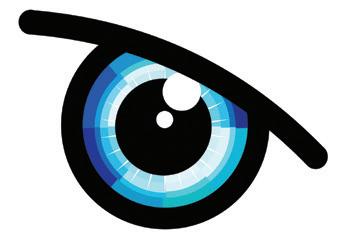
7 minute read
Learn how Cheyenne Ng dresses her walls in moveable colors and textures through the art of macramé


Advertisement
KNOT YOUR AVERAGE WEAVER
How do you make that space your own when you have limited parameters to change it? Living in rental apartments with strict rules on painting, Cheyenne Ng had to come up with inventive ways to put color, decoration, and her own stamp on things. She set out to dress her walls in moveable colors and textures through the art of macramé.
Cheyenne’s skills are self-taught. She researched videos and tutorials teaching the basic forms in macramé and learned the elemental knots of the craft. Staying away from tutorials in style and advanced workings enabled Cheyenne to develop her own unique designs without copying or building on others in the fiber community. For the most part, macramé was a personal side project for Cheyenne, just a hobby. She created a large five-foot by five-foot hanging backdrop for her wedding and it was then that Loomchi was born. Her company’s name comes from a combination of “Chi,” Cheyenne’s nickname in high school, and the loom she uses to create some of her larger pieces.
Cheyenne doesn’t sketch or plan out her designs, although she admires those who do and admits it might save her time. Instead she prefers to let her ideas populate as she begins with an open mind and just starts knotting her cord and materials. She focuses mainly on color selection using different and unexpected combinations while testing color theory. Her pieces range from mini tassel earrings to wreaths to large macramé wall hangings. When asked about her favorite pieces, Cheyenne says, “I love working on the macroscale. I have a four foot wide loom that uses a lot of material and takes a long time, but the larger canvas allows me to explore more and the piece has more time to take shape.” When working with these ‘macraweaves,’ she will incorporate merino, alpaca, or felted wool with her corded cotton rope. She can also work in velvet, satin, or even specialty hand spun yarn that adds a different depth and texture to the weave. One of these four foot works of art can take her anywhere from one to two weeks to complete. Her macramé pieces are generally lighter and airier with a ‘see through’ quality about them while her ‘macraweaves’ tend to be thicker and heavier but still have the fringe associated with macramé hangings.
When Cheyenne isn’t knotting her Loomchi designs, she’s at her full time job as a marketing director or out hiking with her husband Steven and their Jindo dog “Q” exploring the beauty of the Trinity Alps.

LOOMCHI PRODUCTS CAN BE FOUND IN CHICO AT BIDWELL SUPPLY CO., ON HER WEBSITE LOOMCHI.COM OR ON INSTAGRAM @LOOMCHIDESIGNS
2 20 Looking Through A Cracked Rearview Mirror

Tension. Great for suspension bridges like the Golden Gate and Brooklyn. Not so great for the Thanksgiving dinner table when a teenage daughter flees, escaping the brutal remark from her agitated father. The difference between tautness and tenseness needs to be taught. The distinction between anxiety and hostility implores not only recognition but, more importantly, awareness. Tension swells.
A model of swelling tension took place on the campus of Kent State University, May 4 th , 1970. The tension peaked midday on a Monday, three days into student protests against the U.S. military activities in Southeast Asia. The tension between the students and the Ohio National Guard was palpable. The weekend standoff added mounting emotions, resulting in the students abandoning the area known as the Commons and moving to nearby Blanket Hill on the side of the practice football field. This move exposed the Guardsmen, basically up against the fence enclosing the field itself. These members of the Ohio National guard were no older than the student protestors and were left fearful and anxious from the prior days’ events. In their own minds, they believed their lives were in danger. At 12:24 p.m. with both sides firmly in place, the mounting nervousness crashed into a breaking point. The camera of a Kent State photojournalism student ejected its oversized flashbulb from its oversized metal cone launching it on the concrete below where it exploded. In just over a 13- second period, nearly 70 shots were fired from the M-1 rifles. Some were aimed straight up in the air, others into the ground. The result was the death of four Kent State students while nine others were injured from the rain of bullets. The incident was immortalized on the cover of Time magazine with the Pulitzer Prize winning shot of photographer John Filo laying bare the image of 14-year-old Mary Vecchio crying over a fallen body just after the last shot was fired. She was posed on one knee with her hands up crying for help. Pressure, stress, and the disquiet triggered by the turmoil of the times.
So, we now find ourselves discovering what happens when a pandemic is faced with a crisis? I feel certain the stillness the pandemic demanded spurred the ensuing movement. As a result, I believe it also worked up the need for a necessary vocabulary lesson. Whatever the word “essential” meant before COVID-19 has certainly been put to a remarkably ambiguous test since. “Unprecedented” carries with it the weight of being “unheard-of” and “unrivaled” which begs the question of just how and why it is so questioned. Though “protest” and “riot” are listed as direct synonyms, the denotation and connotation of both suggest they are rather antonyms. Protest is “to give manifest expression to objection or disapproval,” while riot is “a noisy, violent public disorder.” Clearly then, when a city’s professional team brings home a championship trophy, too often, the excited and elated crowd breaks into an unnecessary riot. It is also important, when speaking or writing, to take caution with the use of absolutes such as “all” and “never.” Lastly, make no mistake, the word “systemic” means “the actuality of absorbing and circulating from within thus affecting the whole.” “Systematic” is a line from a song in the musical Grease. One eventuality remains obvious, words are one thing, action is altogether another.
I have recently been reminded that William Golding was right, proving how far ahead of the time he was. He wrote the novel, Lord of the Flies, a story about a plane crash on a remote island leaving children as the only survivors. Golding tried to show how difficult it would be for children to survive without adults, suggesting that children can act dangerously without adults accompanying them. Golding fought in World War II for the British army and the violence and terror demonstrated a huge influence on him about human life. The notion of no adults on the island is often likened to a country without proper leadership. At one point the kids, desperate to agree on ways to keep order, ask, “Which is better—to have laws and agree, or to hunt and kill?” They adopt a conch, a large, milky-white shell, symbolizing to the boys a civilized society representing power and order. The power represented by the fact that you have to be holding the conch to speak. Ultimately, the boys break into two groups, warring factions separated by fear and hate. In the end, one group indeed hunts the other with intent to kill. Over an accidental death and the complete obliteration of the conch, the boys look at each other and burst into tears.They cry out in anguish, "What are we? Humans? Or animals? Or savages?" Golding, himself, remained adamant that the interpretation of the story was up to the reader and refused to select one from the many explanations. Certainly, in light of his symbolic message, a worthy question may very well be posed today, in our civilized society—“What are we?”
I will leave you with this. In the overall unprecedented times we currently reside, I truly hope one comes to an end and one never does. Martin Luther King, Jr. put it this way—“Our lives begin to end the day we become silent about things that matter.”











